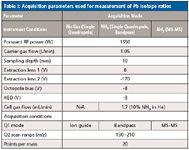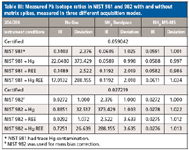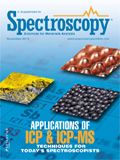Triple-Quadrupole ICP-MS Provides Improved Performance for Difficult Polyatomic and Isobaric Overlaps on Lead Isotopes
Triple-quadrupole inductively coupled plasma–mass spectrometry (ICP-MS) can operate in MS-MS mode, which offers the potential to improve the removal of spectral interferences compared to conventional quadrupole ICP-MS with a collision–reaction cell, or high-resolution ICP-MS.
Triple-quadrupole inductively coupled plasma–mass spectrometry (ICP-MS) can operate in MS-MS mode, which offers the potential to improve the removal of spectral interferences compared to conventional quadrupole ICP-MS with a collision–reaction cell, or high-resolution ICP-MS. In this article we describe how an application that has proved problematic for quadrupole ICP-MS and high-resolution ICP-MS can be addressed using a reaction gas method with triple-quadrupole ICP-MS.
Inductively coupled plasma–mass spectrometry (ICP-MS) is widely accepted as the most powerful instrumental technique for trace-level multielement analysis in industrial, commercial, and research laboratories. Continuous product development over the past 25 years has led to improvements in quadrupole ICP-MS that address most of the problematic spectral interferences that were identified in the early days of the technique (1,2). The relatively recent introduction of collision–reaction cell technology for quadrupole ICP-MS (3) has led to improved accuracy for many previously interfered elements (4), and high-resolution sector-field ICP-MS (HR-ICP-MS) can also resolve many spectral overlaps that affect measurements made using conventional quadrupole ICP-MS (5). Usually, quantitative ICP-MS methods use the primary or preferred isotope of analyte elements, but ICP-MS is also used for determining variations in natural or radiogenic isotope ratios, enriched isotope tracer studies, and quantification using isotope dilution (6–8). In all these cases, spectral interferences on two or more isotopes of the analyte must be removed using a single set of acquisition conditions, which often proves problematic. In this article we demonstrate how triple-quadrupole ICP-MS can improve performance for isotopic analyses for which the interferences cannot be adequately addressed either by quadrupole ICP-MS with a collision–reaction cell or by HR-ICP-MS.
A key application for which interferences cannot be addressed satisfactorily using either quadrupole ICP-MS or HR-ICP-MS concerns the case of direct isobaric overlaps, as opposed to the more typical polyatomic ion overlaps. All naturally occurring elements apart from In have at least one isotope that is free from direct overlap from an isotope of another element, but in the case of isotope ratio measurements, where more than one isotope must be measured accurately, the secondary isotope will often be overlapped by an isotope of a different element. Lead (Pb) is an example, where the 3 major isotopes 206Pb, 207Pb, and 208Pb are all free from direct isobaric overlap, but the minor isotope 204Pb is overlapped by 204Hg.
The ratio of abundances of the Pb isotopes is used in several applications, including environmental monitoring, food provenance, archaeological and metallurgical analysis, and most notably geochronology. For Pb/Pb dating it is necessary to correct for the "natural" or "common" Pb that was present in the sample, by measuring the nonradiogenic isotope of Pb (204Pb) as the reference isotope. However, 204Pb suffers a direct interference from 204Hg: Although Hg may not be present at high concentrations in many samples, 204Pb is a minor isotope (1.4% abundance) so even a small contribution from Hg can adversely affect the accuracy of the measured Pb ratios (9).

Figure 1: Schematic illustration of MS-MS mode with NH3 reaction gas for the interference-free measurement of 204Pb after removal of 204Hg after neutralization by charge transfer.
Commercial HR-ICP-MS instruments can operate at a resolution of up to ~10,000, which is sufficient to separate most common polyatomic overlaps. However, isobaric interferences are much closer in mass than most polyatomic interferences. Separating 204Hg (accurate mass 203.973481 u) from 204Pb (accurate mass of 203.973037 u) would require a resolution (M/ΔM) of almost 500,000, far beyond the capability of current HR-ICP-MS instruments (10).
According to their relative reactivity, separation of 204Hg from 204Pb by "chemical resolution" using ammonia (NH3) reaction gas should be possible. NH3 should neutralize the Hg+ ions by charge transfer according to the following reaction: Hg+ + NH3 → Hg0 + NH3+, followed by NH3+ + NH3 → NH4+ + "NH2." 204Pb+ is unreactive with NH3 and should remain at its original mass, now free from overlap by 204Hg+. But with quadrupole ICP-MS, other ions from the sample matrix will enter the cell and react; many different product ions may be formed at each monitored mass, especially when a highly reactive cell gas such as NH3 is used (11).
A triple-quadrupole ICP-MS method using NH3 reaction cell gas in conjunction with MS-MS mode has been developed for this application, demonstrating improved performance compared to both quadrupole ICP-MS with a collision–reaction cell, and HR-ICP-MS.
Experimental
Instrumental
The Agilent 8800 ICP-QQQ (Tokyo, Japan) triple-quadrupole ICP-MS instrument used in this work has been described previously (12). The tandem mass spectrometer configuration allows the instrument to be operated in MS-MS mode, where both Q1 (before the collision–reaction cell) and Q2 (after the collision–reaction cell) operate as unit mass filters. This mode controls the ions that are involved in reactions with the cell gas, because all nontarget (off-mass) ions are excluded from the cell by Q1. This provides the necessary control of the reaction chemistry needed to separate isobaric overlaps and prevent the formation of new product ion overlaps.
The standard triple-quadrupole ICP-MS instrument configuration with a MicroMist glass concentric nebulizer (Glass Expansion), a quartz sample introduction system, and nickel interface cones was used. Operating conditions are shown in Table I.

Table I: Acquisition parameters used for measurement of Pb isotope ratios
Calibration Standards and Sample Preparation
All of the standards used for this work were prepared using single-element stock solutions (Spex CertiPrep, Claritas grade). The Pb isotopic standards NIST 981 and 982 were obtained from the National Institute of Standards and Technology (NIST).
Analytical Method
Scan-mode acquisitions were used to allow the Pb isotope abundance spectra to be compared, and to investigate the effectiveness of the NH3 cell gas method for removing both the isobaric (204Hg+) and any potential existing and cell-formed polyatomic ion overlaps.
Three acquisition modes were compared:
- No gas: No reaction cell gas; single-quadrupole mode with Q1 operating as an ion guide.
- NH3 bandpass: Ammonia reaction gas; single-quadrupole mode with Q1 operating as a bandpass filter.
- NH3 MS-MS: Ammonia reaction gas; MS-MS mode with Q1 operating as a mass filter at unit mass resolution.
Results
The removal of the 204Hg interference on 204Pb used direct, on-mass measurement of the 204Pb. This mode is used when the chosen cell gas, in this case NH3, is more reactive with the interference than with the analyte ion.
A comparison of the spectra obtained for Pb in the presence of Hg is illustrated in Figure 2. Figure 2a shows that the 204Hg isotope causes a large error in the apparent signal for 204Pb in no-gas mode. Figure 2b shows the same sample measured in NH3 mode, demonstrating the removal of the Hg+ signal and the consequent good isotopic template fit for the Pb isotopes including 204Pb. Figure 2 also confirms that NH3 cell gas does not cause significant loss of analyte ion sensitivity for Pb (or Tl).

Figure 2: Comparison of spectra for a solution containing 1 µg/L Pb and Tl, and 10 µg/L Hg, measured by triple-quadrupole ICP-MS in (a) no-gas mode and (b) NH3 cell gas mode. The natural isotopic abundances for Pb and Tl are indicated by the green and red boxes, respectively.
With the complex geological sample types for which accurate common Pb analysis is needed for isotopic abundance correction, the presence of other matrix and trace elements will lead to a highly complex product ion spectrum. NH3 cell gas combines with the rare earth elements (REE) present in the sample to form NH3 cluster ions that can overlap all the isotopes of Pb, as shown in Table II.

Table II: Examples of REE-NH3 cluster ions that may affect the measurement of the Pb isotopes when NH3 cell gas is used with quadrupole ICP-MS
The potential impact of these REE-NH3 cluster ions on the accurate measurement of Pb isotope ratios is illustrated in Figure 3, which compares the NH3-mode spectra obtained in single-quadrupole bandpass and MS-MS mode for a sample containing Pb, Tl, Hg, and a matrix of 100 µg/L of each REE. In single-quadrupole bandpass mode (Figure 3a), the coexisting REE (and other analyte and matrix ions) can enter the cell and react with the NH3 cell gas, forming a series of cluster ions that affect every mass. All the Pb isotopes are overlapped to varying degrees, meaning that accurate Pb isotope ratio analysis and effective 204Pb common lead correction are not possible in this acquisition mode.

Figure 3: Comparison of spectra for a solution containing 1 µg/L Pb and Tl, 10 µg/L Hg, and 100 µg/L mixed REE spike, measured by triple-quadrupole ICP-MS with NH3 cell gas in (a) single-quadrupole bandpass mode and (b) MS-MS mode. The natural isotopic abundances for Pb and Tl are indicated by the green and red boxes, respectively.
In contrast, Figure 3b shows the MS-MS mode spectrum for the same sample measured in the same NH3 cell gas mode. In MS-MS mode, the Pb isotopes are free from REE-NH3 cluster ion overlap, meaning that NH3 cell gas can be used reliably to remove the 204Hg overlap on 204Pb, even in the presence of REEs.
MS-MS mode with NH3 cell gas was used to measure Pb isotope ratios in the presence of the matrix components discussed above. NIST-certified Pb isotopic standards NIST 981 and 982 were measured in the three acquisition modes: no gas, NH3 bandpass, and NH3 MS-MS.
The isotope ratio results for 204Pb/206Pb are presented in Table III, which shows the measured ratios in the two isotope reference materials, each of which was spiked with various matrix elements (Hg, REE, and Hg + REE). In NH3 MS-MS mode, accurate ratios were obtained in all of the samples, demonstrating the effectiveness of MS-MS mode with NH3 cell gas for interference removal while eliminating the possibility of creating cell-formed reaction-product cluster ions.

Table III: Measured Pb isotope ratios in NIST 981 and 982 with and without matrix spikes, measured in three different acquisition modes.
Conclusions
The use of triple-quadrupole ICP-MS with MS-MS mode has been shown to successfully address some long-standing interference problems that affect quadrupole ICP-MS.
For Pb isotope ratio analysis where accurate measurement of the common lead (204Pb) signal is required, triple-quadrupole ICP-MS with MS-MS enables NH3 cell gas to be used successfully to remove the 204Hg overlap on 204Pb. In MS-MS mode, Q1 excludes other coexisting analytes or matrix elements from the reactions, eliminating the formation of REE-NH3 cluster ions and ensuring that accurate Pb ratios can be measured in complex and variable samples that contain both Hg and REEs.
References
(1) A.L.Gray, Fresenius' Z. Anal. Chem. 324, 561–570 (1986).
(2) R.C. Hutton and A.N. Eaton, J. Anal. At. Spectrom. 2, 595–598 (1987).
(3) P. Turner, T. Merren, J. Speakman, and C. Haines in Plasma Source Mass Spectrometry, Developments and Applications, G. Holland and S.D. Tanner, Eds. (The Royal Society of Chemistry, Cambridge, 1997), pp. 28–34.
(4) E. McCurdy and G. Woods, J. Anal. At. Spectrom. 19, 607–615 (2004).
(5) N. Bradshaw, E.F.H. Hall, and N.E. Sanderson, J. Anal. At. Spectrom. 4, 801–803 (1989).
(6) F. Vanhaecke, L. Balcaen, and D. Malinovsky, J. Anal. At. Spectrom. 24, 863–886 (2009).
(7) T. Ohno, Y. Muramatsu, Y. Shikamori, C. Toyama, N. Okabea, and H. Matsuzaki, J. Anal. At. Spectrom. 28, 1283–1287 (2013).
(8) L. Balcaen, G. Woods, M. Resano, and F. Vanhaecke, J. Anal. At. Spectrom. 28, 33–39 (2012).
(9) C.D. Storey, T.E. Jeffries, and M. Smith, Chemical Geology 227(1-2), 37–52 (2006).
(10) N. Jakubowski, T. Prohaska, L. Rottmann, and F. Vanhaecke, J. Anal. At. Spectrom. 26, 693–726 (2011).
(11) B. Hattendorf and D. Gunther, J. Anal. At. Spectrom. 15, 1125–1131 (2000).
(12) S.D. Fernandez, N. Sugishama, J.R. Encinar, and A. Sanz-Medel, Anal. Chem. 84, 5851–5857 (2012).
Ed McCurdy and Glenn Woods are with Agilent Technologies (UK) Ltd. in Stockport Cheshire, UK. Direct correspondence to: ed_mccurdy@agilent.com

High-Speed Laser MS for Precise, Prep-Free Environmental Particle Tracking
April 21st 2025Scientists at Oak Ridge National Laboratory have demonstrated that a fast, laser-based mass spectrometry method—LA-ICP-TOF-MS—can accurately detect and identify airborne environmental particles, including toxic metal particles like ruthenium, without the need for complex sample preparation. The work offers a breakthrough in rapid, high-resolution analysis of environmental pollutants.
Trending on Spectroscopy: The Top Content of 2024
December 30th 2024In 2024, we launched multiple content series, covered major conferences, presented two awards, and continued our monthly Analytically Speaking episodes. Below, you'll find a selection of the most popular content from Spectroscopy over the past year.